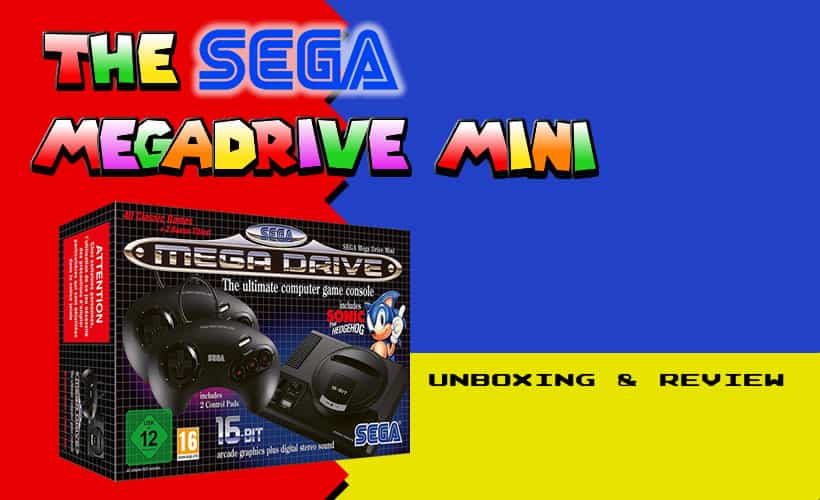
The Sega Megadrive Mini – An Unboxing and Review
Today is a special day for us Europeans. After a two week delay due to ‘unavoidable logistical challenges’ the Sega Megadrive Mini has finally been released and is available to buy in Europe! So, I have wasted as little time as possible drewelling and rubbing my hands, and have snapped up one of the first available units.
I plan to make this unboxing/review as thorough as I can so if you’re pushed for time and not interested in wading through the entire article, here is a brief summary on my thoughts about the Megadrive Mini.
With 42 built in games and taking up almost 50% less space than it’s big brother, the Sega Megadrive Mini is a welcome addition to the growing classic console market. Sega and M2 have rigorously replicated the appearance of the original Megadrive and switching the machine on for the first time will bring a wave of nostalgia flooding over you. All games play pretty much identically to their original cartridge versions and the added addition of the save state functionality means you will not become stuck in the never ending time loop of restarting an unbeatable level everytime you die at the end. At a price of £69.99 it may be slightly overpriced, but if you’re looking for top quality over quantity when it comes to playing your old 16 bit Sega games, go for the Megadrive Mini.
CHECK PRICE ON AMAZONNow let’s get into the nitty gritty…
Unboxing the Sega Megadrive Mini
Ok, so the first impressions you get on the Megadrive Mini are from the box and the box art and I’m happy to say it doesn’t let you down. Like the console in general Sega have strived to recapture the image of the original Megadrive in the packaging. Size wise the box has similar dimensions to the packaging of the original, but obviously smaller. In fact when I picked the unit up from the store I was surprised to see how small the packaging actually was. As for the box art Sega have faithfully replicated the style that was present on the original packaging… Nostalgia overload starts here.
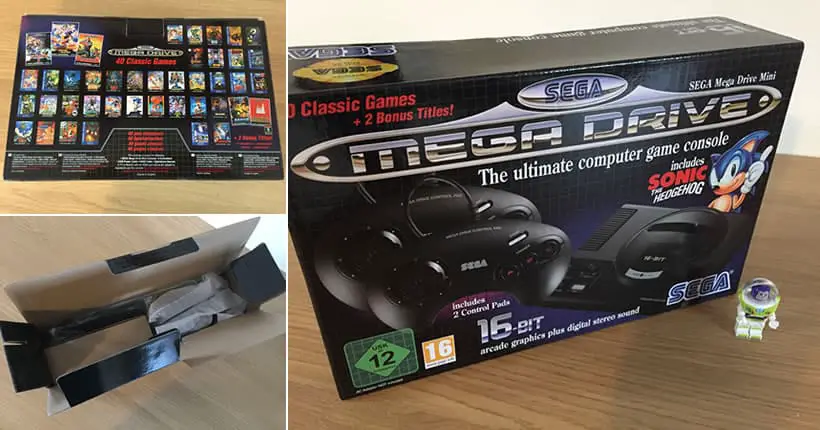
Opening the box for the first time everything is neat and tightly packaged. Every object in the box has been self contained in it’s own plastic or foam back. The console itself is actually stored in its own little cardboard box which could be used for future storage and transport if you so choose.
Contained in the box is, the console itself, two 3 button controllers, an HDMI lead, a micro USB to USB lead to use as a power cable and the instruction manual. I was a little disappointed to notice that an AC adapter had not been included with the package. Granted, most people will have dozens of USB plugs knocking around. It just feels a little bit penny pinching on Sega’s part not to include a plug in the European package when I’m sure it’s included for other regions.
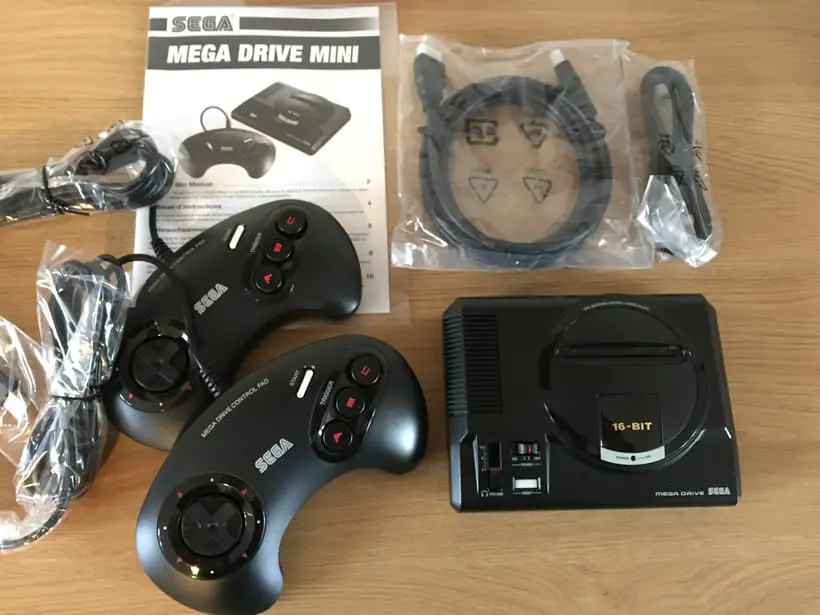
Console Appearance
Taking the console out of it’s packaging, the first thing that hit me was how delightfully tiny it was. I knew the Megadrive Mini was going to be small and had seen video clips and images of it all over the place, but these just don’t do it justice. This thing is absolutely tiny!
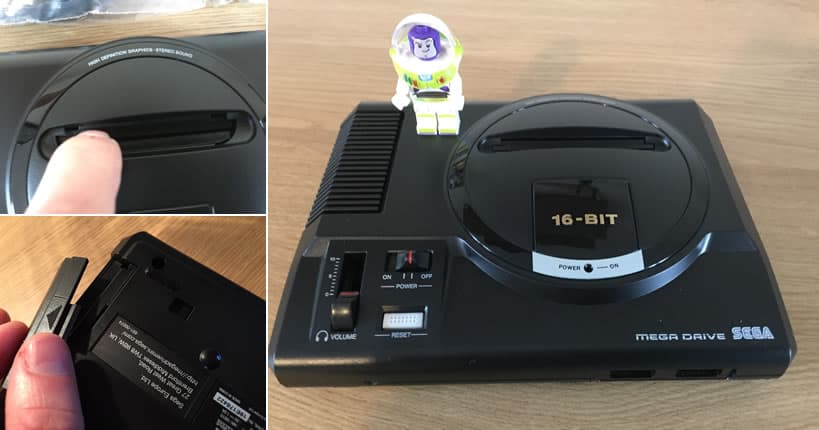
When designing this new console Sega pulled out all the stops. They have painstakingly replicated every feature of the original Megadrive (save for the 5mm audio port at the front) and shrank it down by almost 50%
Every button that was present on the original has been included and is functional to some extent. The only button that doesn’t serve an electronic function is the volume slider (I don’t know anyone who actually used this in the first place) but this still slides up and down. The on/off switch serves the same purpose as the original model to power up the device and shut it down, while the reset button brings up a menu when playing the games.
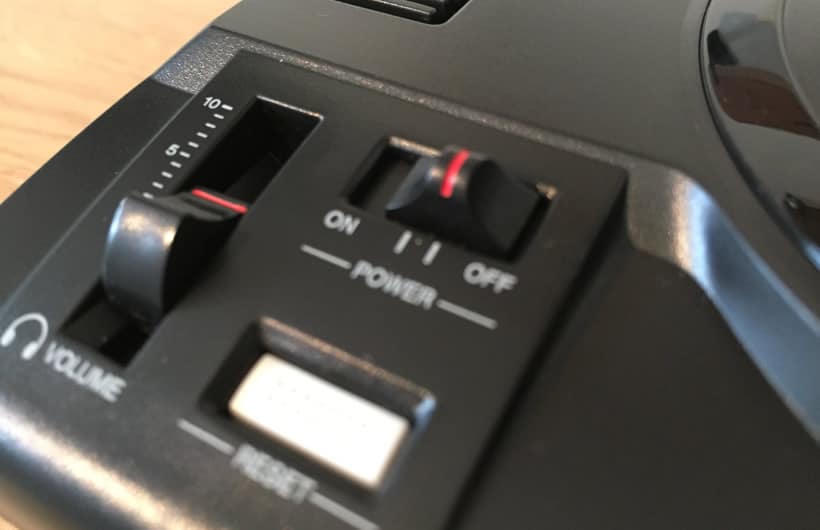
Sega have also replicated the original’s cartridge slot on the console complete with spring loaded flaps which close automatically. While the cartridge slot itself is non-functional it will accommodate mini cartridges which you can 3D print and swap in and out for that added feeling of realism and nostalgia. In other markets mini cartridges (again, non-functioning) are available to purchase but more on that later.
There is even a removable expansion port cover underneath the unit which clips easily on and off exactly as it did on the original. The expansion port itself is non-functional but this is nonetheless a very nice attention to detail.
The 2 controller ports of the original have been replaced with 2 USB ports which are still used for the controllers. These are placed in exactly the same position as the old controller ports and serve the task of replicating the look and feel.
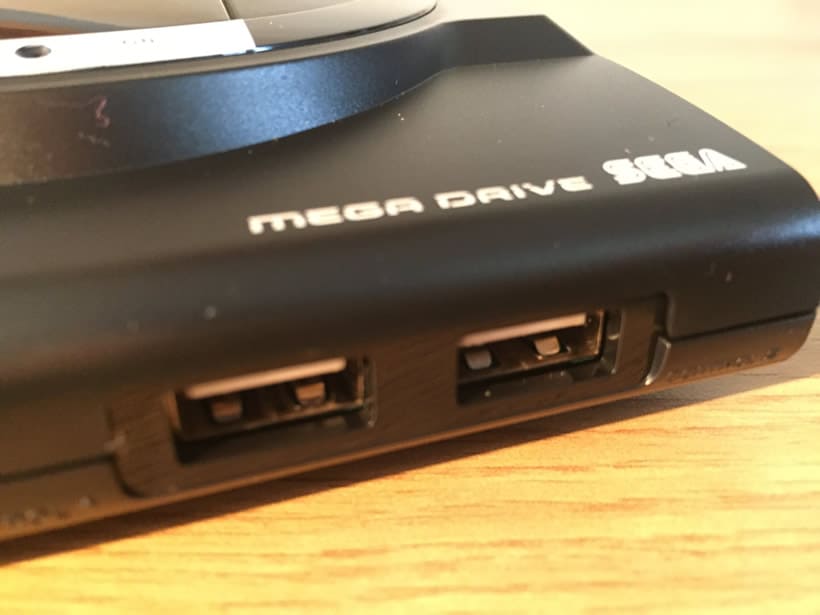
At the rear of the console you will find the connectivity ports which consist of an HDMI port and a micro USB port which powers the system. These replace the old barrel jack power port and the RF port.
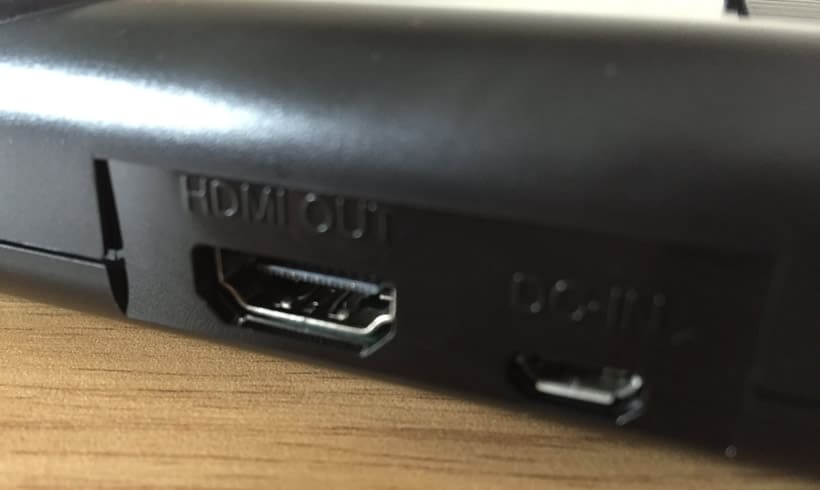
Games List
As mentioned before the Megadrive Mini comes prepackaged with 42 built in games, 2 of which (Tetris and Darius) were never actually released on the original console. Here is a list of every game included on the system along with their genre and average review score from back when they were originally released. For a more in depth description of each game check out our previous blog – The Sega Megadrive Mini – What to Expect
| Game Title | Genre | Original Review Score |
|---|---|---|
| Alex Kidd in the Enchanted Castle | Platformer | 47% |
| Alisia Dragoon | Platformer/shoot-em-up | 87% |
| Altered Beast | Beat-em-up | 51% |
| Castle of Illusion Starring Mickey Mouse | Platformer | 95% |
| Castlevania: Bloodlines | Platformer | 83% |
| Columns | Puzzler | 90% |
| Comix Zone | Beat-em-up | 89% |
| Darius | Shoot-em-up | New release |
| Dr. Robotnik’s Mean Bean Machine | Puzzler | 90% |
| Dynamite Headdy | Platformer | 93% |
| Earthworm Jim | Platformer | 92% |
| Ecco the Dolphin | RPG | 97% |
| Eternal Champions | Beat-em-up | 97% |
| Ghouls ‘n Ghosts | Platformer | 92% |
| Golden Axe | Beat-em-up | 91% |
| Gunstar Heroes | Shoot-em-up | 93% |
| Kid Chameleon | Platformer | 78% |
| Landstalker | RPG | 94% |
| Light Crusader | RPG | 89% |
| Mega Man: The Wily Wars | Platformer | Unknown |
| Monster World IV | Platformer | Unknown |
| Phantasy Star IV: The End of the Millennium | RPG | 88% |
| Probotector | Platformer/Shoot-em-up | 75% |
| Road Rash II | Driving | 88% |
| Shining Force | RPG | 91% |
| Shinobi III: Return of the Ninja Master | Platformer/beat-em-up | 88% |
| Sonic Spinball | Platformer | 81% |
| Sonic the Hedgehog | Platformer | 92% |
| Sonic the Hedgehog | Platformer | 96% |
| Space Harrier II | Shoot-em-up | 77% |
| Street Fighter II: Special Champion Edition | Beat-em-up | 92% |
| Streets of Rage 2 | Beat-em-up | 92% |
| Strider | Platformer | 92% |
| Super Fantasy Zone | Shoot-em-up | Unknown |
| Tetris | Puzzler | New release |
| The Story of Thor | RPG | 93% |
| Thunder Force III | Shoot-em-up | 86% |
| ToeJam & Earl | Platformer | 87% |
| Vectorman | Platformer/shoot-em-up | Unknown |
| Virtua Fighter 2 | Beat-em-up | 52% |
| Wonder Boy in Monster World | Platformer | 88% |
| World of Illusion Starring Mickey Mouse and Donald Duck | Platformer | 90% |
Controllers
Included in the box are a pair of 3 button controllers which are identical to the original devices. Unlike the console, Sega have kept these to the same size as their original counterparts, which is great as it helps to replicate the gaming experience of the original system.
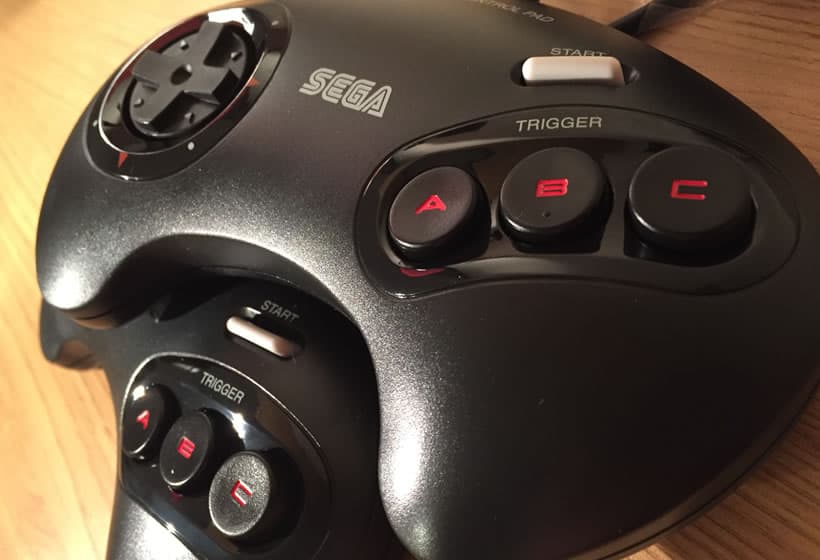
One thing that has upset me and many other loyal retro gamers, is that Sega have decided not to include their 6 button controllers as part of the package instead of the original 3 button controllers. There are two games on the system (Street Fighter 2 and Eternal Champions) that were developed with the 6 button controller in mind and playing them with anything less seriously affects the enjoyment and playability.
The big kick in the proverbial cartridge slot here is that Sega have deemed it acceptable to include the 6 button controllers for the Japan release but not for the US or European exports.
In an attempt to rectify this issue myself I tried a few of my own generic USB controllers with the Mini. I found out that my controller that features analogue joysticks (as well as the necessary amount of buttons) did not function at all and my replica SNES controller worked but the button configuration was way off. Button A was mapped to the left shoulder button which made playing any game extremely awkward. Unfortunately there was no way to remap the controls so both my attempted solutions failed.
Sega have said that the Retro-Bit 8 Button Arcade Pad is compatible with the system (which I can confirm after testing) however this does obviously mean more expenditure on top of the consoles £70 price tag. Is that worth it for just two games? All I can say is, stop being so tight, Sega!
Leads/Display
In order to bring the Megadrive kicking and screaming into the 21st century, Sega have replaced the old video input output ports with a modern HDMI connectivity.
The whole system now displays at a resolution of 1280 x 720 which works brilliantly for these older retro games and produces just the right balance of HD quality with a slight hint of retro pixelation. To be fair, anything more than 720 res may have resulted in the graphics being too blocky, but as it is experiencing your favourite Megadrive classics in the full glory of 720p is a privilege to behold.
Console Review
So, now we get into the important info. What is the Megadrive Mini like once you’ve connected it up and powered it on? Are you able to rekindle that warm sense of pleasure that you experienced when you first switched on your original console all those decades ago? Read on to find out.
Presentation
The first thing you are presented with when you power up the Mini is the game selection screen. All 42 games are represented in grid format, 6 to a row with their original box art which is a very welcome feature. To warm your heart while you select which game you want to play, a nostalgic jingle resembling the music from the final cut scene from Sonic the Hedgehog plays over the top. Once this has run its course the jingles continue with a range of classic tunes from classic Megadrive titles.
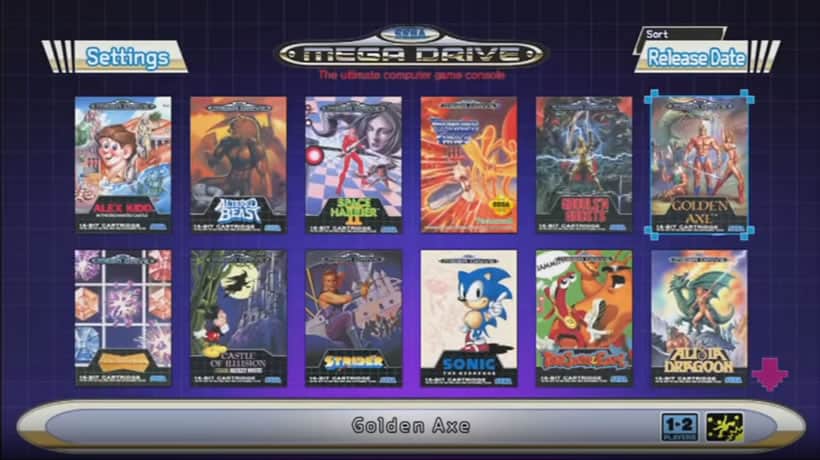
You are able to sort the games list by release date, genre, number of players or alphabetically, and you can also minimise the box art by pressing the B button on the controller. This action allows you to view the spines of the game boxes (as you would see them on a shelf) so that all the games appear on one screen, another nice little feature.
The process of selecting a game is easy enough. Simply use the controller D-pad to highlight which game you want and press the A button.
Before you start playing any of the games you may want to check out what’s on offer in the settings menu in the top left of the games selection screen. Here you can toy with the screen aspect ratio, change the in game wall paper amongst other things. You can also change the language used on the console, but why would you want to do this? Well, there’s a little gem hidden in this option; the language you pick will govern the region variant of each game you play. Some of the games have no difference from region to region, however there are others which feature some very significant variations.
Sonic the Hedgehog for example, utilises parallax background scrolling on the Japanese version. Again, the Japanese version of Dynamite Headdy includes added story elements, different artwork and is less punishing gameplay when compared to its European counterpart. Streets of Rage 2 is called Bare Knuckle 2 in Japan and Probotector is renamed as Contra The Hardcorps and features different characters to play as.
None of these added features are deal breakers as to which version you play, but it is nice to see that Sega have paid so much attention to the little things.
As for the other options in the settings screen, the aspect ratio options gives you 2 choices on how you view your games, 4:3 or 16:9. The 4:3 ratio displays the games as they were originally intended. The 16:9 ratio gives the games a modern look by stretching the view to the width of your screen and removing the need for a background wallpaper. Personally, I would stay away from the 16:9 aspect ratio is not the best option as it distorts the pixels on the screen by making them wider. As a result you see glitches and bugs in some of the games when scrolling, and the sprites basically look like they need to go on a diet. Want my advice? Stick with the 4:3 ratio.
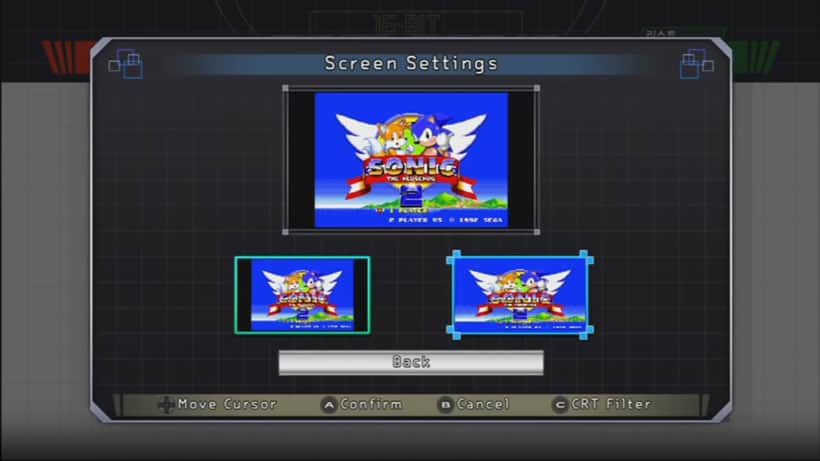
There is also another video option in the screen settings which can be applied to either of the aspect ratios that you have selected. This is the CRT filter and the purpose of this is to attempt to emulate the feel of an old school CRT tv by slightly blurring the image and applying a weak horizontal scan line every other pixel row. It has to be said that this is not the best feature in the world as it just reduces your enjoyment of the game. In my view it only serves a purpose if you’re wondering what playing a game would be like through the eyes of Robocop.
The other setting category of note is the wallpaper settings. When playing games in a 4:3 aspect ratio you are essentially playing in a window which sits on top of a background image. The wallpaper settings gives you the option of filling this background void with one image or another, or nothing at all. I went for the Megadrive grid themed image as opposed to the Sonic speakers, but whichever option you choose has no bearing on the games played.
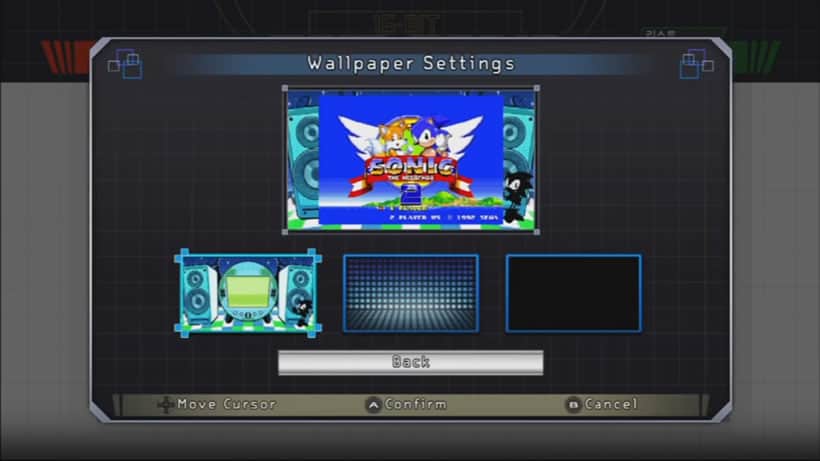
Now, once you finally get in to playing the games be sure to check out the in game options screen. This can be viewed either by pressing the reset button on the console, or by holding down the controller start button.
You have to hold the start button down for some time so it’s quicker to use the reset button.
Also, don’t hold down the start button if you are using the Retro-Bit 6 button controller. This will cause the game to freeze and you will need to reconnect your controller to get it back to full functioning order.
The in game menu is where you can find the save state option. Here you are given 4 slots per game in which you can save your current progress, much like taking a screenshot of the game and going back to that point whenever you need to. Gone are the days of writing out 50 character long passwords only to realise that you’ve made a mistake the next time you try to enter it. A simple tap of a controller button is all that is needed to save your position for as long as you like and return to that position as many times as you like. Thank God for that!
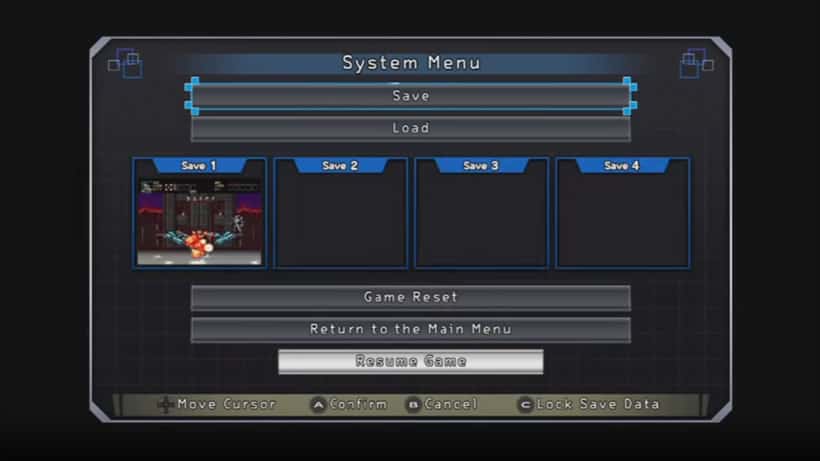
So, that’s all the options and features that the Megadrive Mini has to offer and I have to say I’m very happy with the results. The whole presentation of the interface is crisp and sleek. The menu systems are easy to use and quick to navigate. Features such as the music can get annoying sometimes but thats why the mute button on your tv was invented. Other than that I have no real complaints.
Game Performance
Now we come onto one of the most important aspects of this review. When I first heard that M2 was taking on the challenge of developing the games on the Megadrive Mini I was quietly excited as they have a reputation for fantastic emulation. I am happy to say that I was not disappointed in this regard.
Firstly, the PAL/European version of the original Megadrive ran at 50Hz, however the PAL version of the Mini runs at a faster rate of 60Hz, which is what all Megadrive games were originally designed for. This reduces the possibility of slow down and jerkiness when things get busy on screen and allows for a smoother gaming experience.
Secondly, I noticed very few emulation glitches or bugs which have plagued other developers attempts at similar models. Mentioning no names, AtGames! Too often was the occurrence of playing a game of Outrun only to see the background or road completely disappear and for me to crash. There’s none of that sort of nonsense with the Megadrive Mini. Sure, if you were to look hard and be critical, you would find the odd glitch which did not appear on the cartridge version of the game, however none of these glitches would be so debilitating that it caused you to lose a life or have to restart the game entirely.
The only area where the Megadrive Mini falls slightly short is in the sound department, but this is no surprise as it’s one of the harder areas to perfect. The basic problem is that the sound quality just doesn’t carry the ‘oomph’ that the original system did. Coupled with this, there is also a slight lag (approximately 11 frames) from when an action occurs to when the action sound is heard.
That being said, the sound issue is only a very minor irritation and chances are you will not even notice it. To be honest the only reason I noticed it on a few of the games is because I had played them so much on the original console and had the music and sound effects embedded in my memory.
Best Games
Rather than go through all the games again (as I have already done in this article) I thought I’d just give a brief description on the best and the worst games on the console, so here we go…
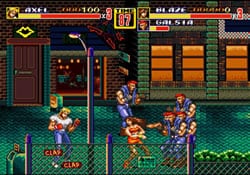
Streets of Rage 2
What more needs to be said about this game? One of the greatest side scrolling beat-em-ups of all time. Choose one of three characters to take a stroll around the roughest streets in town taking time to beat down on numerous identical henchmen and the odd Freddie Krueger inspired boss. Co-op play is also available which adds to a twist at the end. Streets of Rage 2 is one of those rare games that promotes the process, play it, love it, complete it… Play it again!
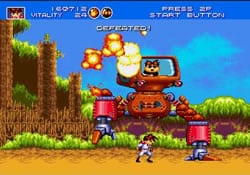
Gunstar Heroes
When it was originally released in September 1993 Gunstar Heroes was the Megadrive’s answer to the Contra games on the SNES, and it is superfluous to it in almost every way. This scrolling shoot-em-up features a wide variety of varied weapons, fast addictive gameplay and awesome graphics. Don’t let this one slip by you.
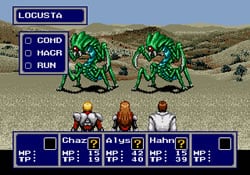
Phantasy Star 4: The End of the Millennium
Not being a big fan of RPGs back in the day, I didn’t really play much of Phantasy Star IV. This was my loss! This game was huge for the time and it will keep you fixed for weeks, especially if you’re a ‘one hundred percenter’ gamer. There is so much to find, and so much to do. If you’re a fan of RPG games and you haven’t played this yet, you’re missing out.
Disclaimer: I left Street Fighter 2 off this list because of the lack of a 6 button controller. You really need a 6 button controller to get the most out of this game. Also, I left Sonic out of this list because everyone knows about sonic… Please don’t hate me
Worst Games
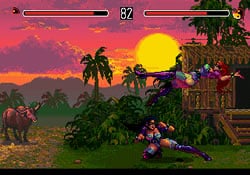
Eternal Champions
Eternal Champions?!? They included Eternal Champions and not Mortal Kombat!?! One of the most overrated games of the nineties, this is a Street Fighter 2 style beat-em-up which shares none of the awesomeness of Street Fighter 2. Forgettable characters, lame graphics and awful music are what I remember about this game and those memories come flooding back as soon as I see the title screen. And to rub salt into the wound you need a 6 button controller to play this game properly. Play it once, then keep it at the bottom of the pile.
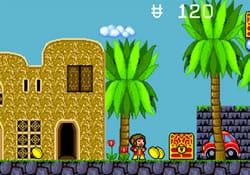
Alex Kidd in the Enchanted Castle
Here we have a very basic platformer that originally saw life on the Sega Master System before it was given a 16-Bit facelift. Unfortunately that facelift was a bit of a botch job as this game suffers from basic graphics that could have been drawn by a 5 year old, imaginative level design and completely unchallenging. If you play this once you may complete it, if you play it twice… well, let’s just say we obviously have different opinions on what makes for a good platformer.
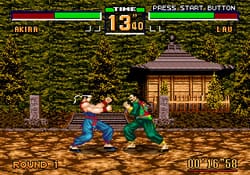
Virtua Fighter 2
Oh dear, oh dear! Who’s idea was it to even develop this version of Virtua Fighter 2 in the first place, let alone include it in the Megadrive Mini library? Gone is the 3-D polygon Virtua effect that is present on the Saturn and 32X versions of the game. Gone are the great graphics and responsive gameplay. All these are replaced by an extremely basic two dimensional Street Fighter clone which is trying to live off it’s famous name. Its jerky, its boring, it looks bad! Do yourself a favour and send this over privileged child to a boarding school… in other words, play it once and forget it.
Missing Games
Despite the fact that the Megadrive Mini packs twice as many games into its cartridge slot when compared to the NES or SNES Classics, there are still a number of games that I feel should have made the final list.
It would have been nice to have seen more of a turn out form the many EA games that have appeared on the Megadrive over the years. One game of particular note would be Desert Strike or one of its sequels. Take to the low level flying skies in this isometric early sandbox based shooter. Choose which missions to do in whatever order you want, this style of gameplay was very unique for the time and fun as hell. With a delicate balance of strategy and run and gun combined, this early title ticked the boxes of many a gamer.
Again, Cannon Fodder was a game that was completely unique on the Megadrive and so addictive that it contributed to widespread insomnia amongst gamers. Sure, it was a point and click games which isn’t necessarily suited to consoles in general, but rules like that are made to be broken and Cannon Fodder breaks the hell out of it.
Flashback was another very unique game to appear on the Megadrive and, at the time, was one of the best version on any console. Awesome vector based graphics combined with an in depth storyline led to one of the most immersive titles on the Megadrive. True, this type of game isn’t for everyone as it can be a little slow but it’s ideal for adding a little bit more variety to the games list.
One theory I have as to why some of these games didn’t make the final cut is this; during the mid nineties Sega felt it necessary to redesign the Megadrive and developed the Megadrive 2. Could it be that they are planning on releasing a Megadrive Mini 2? For me this would be an awesome bit of marketing and an ideal opportunity to include some of the classic games that were missed in the first draft. Nothing has been announced by Sega as yet and currently this is simply one of my mad theories, but how awesome would this be? Also, it would be nice to get some 6 button controllers this time, Sega!
Final verdict
So, that’s that then. I have listed what I believe are the pros and cons to this new mini console below but let me just say a few final words about it.
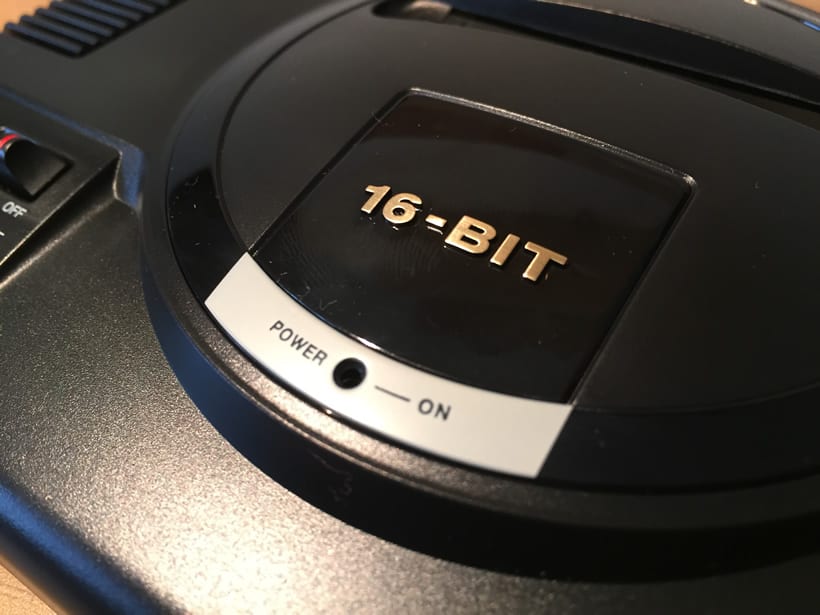
It is clear to see that Sega and M2 have painstakingly attempted to replicate every minor detail of the original console in the Megadrive Mini and the result is close to perfection. Yes, the price that Sega is asking for this is slightly high, and there are other competitor models that offer more for your money, but my advice would be to go for quality over quantity and you won’t regret it.
The main purpose of these new Classic/Mini consoles is so that aging gamers such as myself can relive the glory days of the 16-Bit era and smile as they remember what it was like to be able to pick up a game and play it without having to read the instructions or go through a tutorial. The Sega Megadrive Mini will thump you in the face with a massive hit of nostalgia but keep you coming back for more with a varied library of games and the near flawless emulation of these games.
Would I recommend this to you? Indeed, wholeheartedly, I would!
CHECK PRICE ON AMAZONPros
- Perfectly resembles the original console
- Extreme attention to detail in every way
- Games play perfectly, the best out of any system of it’s kind
- Large number of games included
Cons
- No 6 button controllers
- Audio lag
- Missing a couple of classics
- High price tag
- No plug included
Related Questions
Are there any accessories? In other markets you are able to purchase a Mega-CD unit which attaches to the bottom of the Megadrive Mini, as well as a 32X, and games cartridges which sit in the cartridge slot. All these units are non-functioning and are added purely for aesthetic purposes. Currently these are only available in Japan and it is not clear whether they will be sold in Europe at this time.
Can I use other controllers? It would seem that the only controller that functions as intended is the Retro-Bit 8 button arcade pad mentioned earlier. I have tried a number of other generic USB controllers and all have either not worked at all or had debilitating button mapping issues. In this case you would need to purchase the premium product, unfortunately.
Can I add games to the Megadrive Mini? No, not at the moment.The Megadrive Mini has been developed as a closed system so Sega never intended for gamers to be able to add their own games. As with many mini consoles like this, however, independent developers are in the process of developing hacks which will eventually allow you to add any number of classic games to the unit. Keep checking back to retro Games Addict as we will be adding a tutorial blog as soon as a hack is released.
